University of Wisconsin officials presented Monday the long-term plan for the university and its facilities with an emphasis on creating more green space, managing storm water and improving campus transportation.
Gary Brown, campus planning and landscape architecture director, said in the past, the university focused on constructing buildings on campus, but this time it wanted to focus on its landscape and open space instead.
“The landscape and open space are just as important as the buildings,” Brown said. “[These open spaces] are actually used for teaching a lot and we hope to expand that.”
Brown said the university hopes to add more green space to the south campus area to make it seem more like a part of campus. Right now the southern campus area feels neither like a part of campus nor like a part of downtown Madison, he said. Adding green space could make that area seem more integrated with the central and west campus areas.
These areas would also give students a place to meet up and hang out, similar to how the Union Terrace and Bascom Hill are used now, Brown said.
In addition to creating more green space on campus, Brown said the university hopes to find a way to stop storm water from flowing directly into Lake Mendota. There are 26 storm drains that currently pour storm water directly into the lake, he said.
Storm water has been depositing phosphorus into Mendota via these outfalls, which is “causing all of the problems in the lake,” Brown said. The university hopes to build infrastructure to slow down the flow of water into the lake and try to treat it before it reaches Mendota. Brown said these methods of reducing storm water flow are known as green infrastructure.
“Green infrastructure is really important for us to figure out how to use storm water as a resource,” Brown said. “We want to either slow it down before it gets to the lake or divert it.”
Brown also addressed the university’s plans to improve travel around campus. He said the university hopes to add and remove certain roads to improve pedestrian and bicycle traffic through certain areas of campus.
In the future, UW hopes to turn Charter Street south of Dayton Street into a two-way street, and to remove a portion of Brooks Street from Johnson Street to Dayton Street. He said he hopes to turn the latter into an area similar to East Campus Mall. UW would also add roads between Charter Street and Henry Mall, and between Linden Street and University Avenue to improve pedestrian traffic.
UW also hopes to add two land bridges. One would be at Charter Street and Linden Street and the other would connect Babcock Drive to Chamberlin Avenue.
Most of these changes would theoretically be implemented no sooner than 20 years from now, Brown said.


